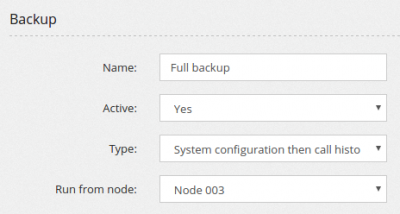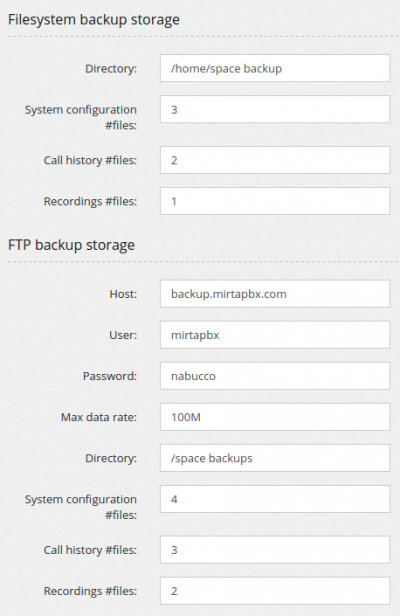Backups: Difference between revisions
No edit summary |
No edit summary |
||
| Line 5: | Line 5: | ||
* voipmonitor : This is the standard voipmonitor database, plus a table for storing the pcaps and graphs. | * voipmonitor : This is the standard voipmonitor database, plus a table for storing the pcaps and graphs. | ||
[[backups.png|400px]] | [[file:backups.png|400px]] | ||
It is advisable to take regular backup. These backup can be automatically copied to an FTP server. | It is advisable to take regular backup. These backup can be automatically copied to an FTP server. | ||
[[backupbackup.png|400px]] | [[file:backupbackup.png|400px]] | ||
You can have several backup running, maybe you can take a daily backup of the configuration and a weekly backup for recordings. You can specify the backup '''type''' and the node from which it is run. | You can have several backup running, maybe you can take a daily backup of the configuration and a weekly backup for recordings. You can specify the backup '''type''' and the node from which it is run. | ||
| Line 25: | Line 25: | ||
You need to specify the database access credentials. The default credentials are root/passw0rd . Database access is granted only from the local server. | You need to specify the database access credentials. The default credentials are root/passw0rd . Database access is granted only from the local server. | ||
[[backupstorage.png|400px]] | [[file:backupstorage.png|400px]] | ||
You need to specify at least a local storage for the backup and then you can specify a remote FTP server storage. It is not possible to make a backup only on the remote storage location. | You need to specify at least a local storage for the backup and then you can specify a remote FTP server storage. It is not possible to make a backup only on the remote storage location. | ||
Revision as of 06:11, 27 December 2016
All configuration data on MiRTA PBX are stored in the database. MiRTA PBX uses three databases:
- asterisk : This is the most important one and contains all the configurations, plus some logs, like the IVR logs, the voicemail messages and the recordings
- asteriskcdrdb : This is the repository for the call logs
- voipmonitor : This is the standard voipmonitor database, plus a table for storing the pcaps and graphs.
It is advisable to take regular backup. These backup can be automatically copied to an FTP server.
You can have several backup running, maybe you can take a daily backup of the configuration and a weekly backup for recordings. You can specify the backup type and the node from which it is run.
Five types of backup are available:
- System configuration : backing up only asterisk database, but not the recordings
- Call History : backing up only the call history asteriskcdrdb database
- Recordings : backing up only the re_recordings table (usually pretty huge)
- System configuration then Call History : a combination of the first two
- System configuration then Call History then Recordings : a combination of the first three
Scheduling can be checked also from Admin/Global Configuration/System Cronjobs
You need to specify the database access credentials. The default credentials are root/passw0rd . Database access is granted only from the local server.
You need to specify at least a local storage for the backup and then you can specify a remote FTP server storage. It is not possible to make a backup only on the remote storage location.


